University Practice Reflection Assessment Task PUBH641
VerifiedAdded on 2022/11/01
|5
|1588
|152
Homework Assignment
AI Summary
This assignment is a practice reflection task for a student enrolled in the Masters in Public Health program, specifically focusing on the HLSC621 Introduction to Health Sciences Research unit. The reflection covers several key lessons from the course, including qualitative research paradigms, systematic literature searches, quantitative research designs, and evidence-based medicine. The student discusses the strengths and weaknesses of qualitative research, the importance of literature reviews, and the application of different study designs like cross-sectional, case-control, and cohort studies. The reflection also touches upon statistical terms, levels of evidence, and critical appraisal of research articles. The student highlights how the course content has enhanced their understanding of research methodologies and its application in public health practice, emphasizing the importance of evidence-based decision-making and the ability to critique research literature. The assignment demonstrates the student's grasp of various research concepts and their ability to connect them to future practice as a public health professional.
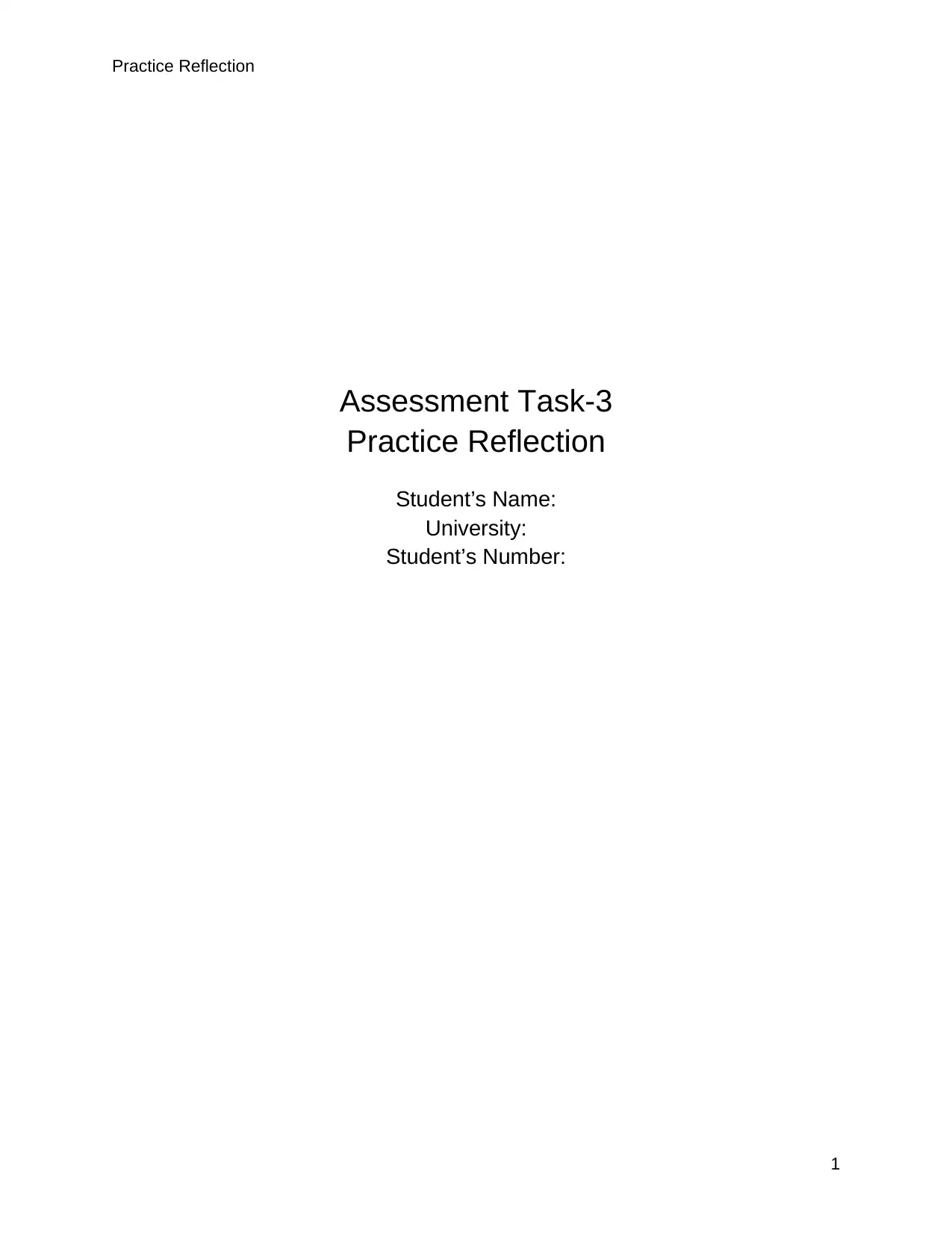
Practice Reflection
Assessment Task-3
Practice Reflection
Student’s Name:
University:
Student’s Number:
1
Assessment Task-3
Practice Reflection
Student’s Name:
University:
Student’s Number:
1
Paraphrase This Document
Need a fresh take? Get an instant paraphrase of this document with our AI Paraphraser
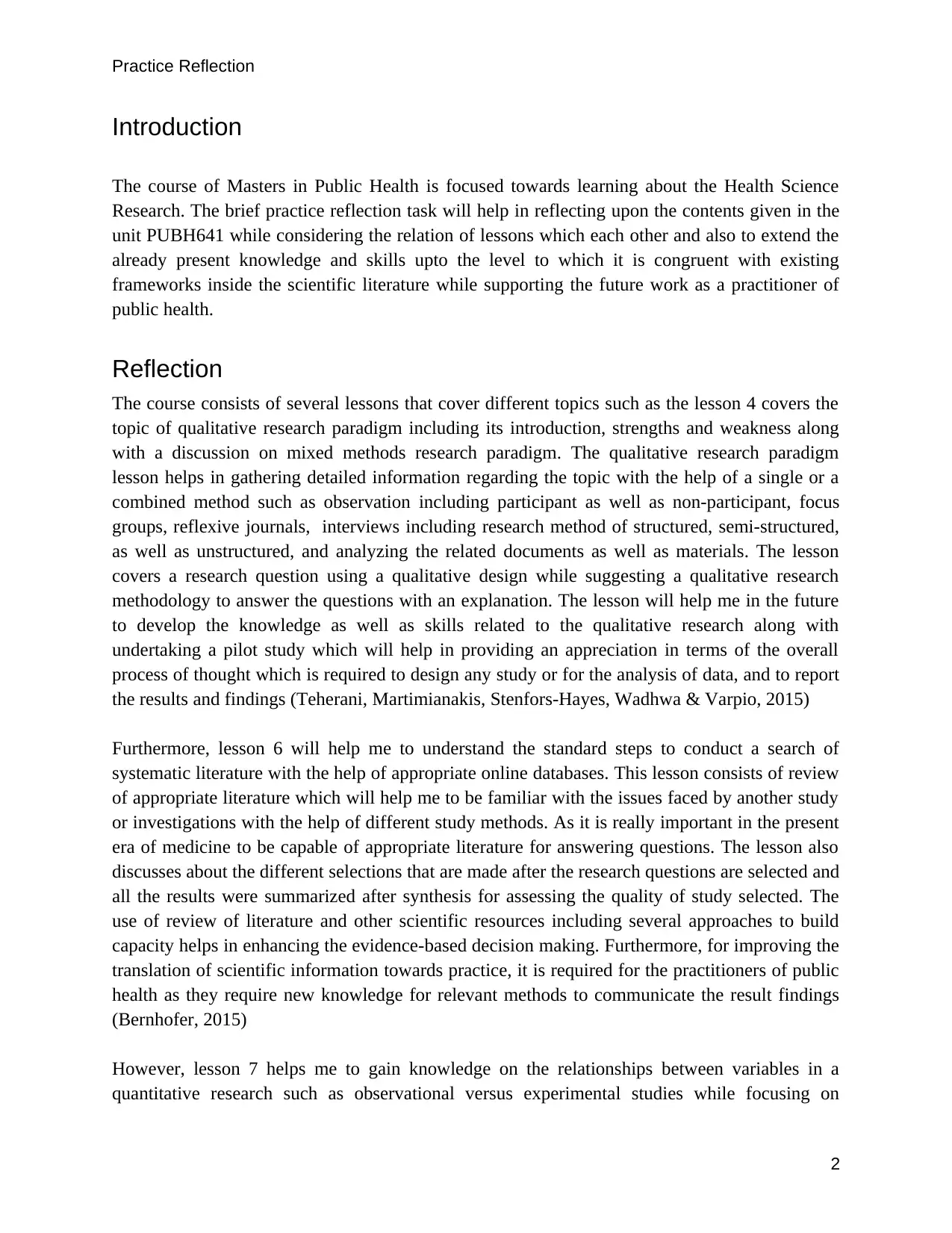
Practice Reflection
Introduction
The course of Masters in Public Health is focused towards learning about the Health Science
Research. The brief practice reflection task will help in reflecting upon the contents given in the
unit PUBH641 while considering the relation of lessons which each other and also to extend the
already present knowledge and skills upto the level to which it is congruent with existing
frameworks inside the scientific literature while supporting the future work as a practitioner of
public health.
Reflection
The course consists of several lessons that cover different topics such as the lesson 4 covers the
topic of qualitative research paradigm including its introduction, strengths and weakness along
with a discussion on mixed methods research paradigm. The qualitative research paradigm
lesson helps in gathering detailed information regarding the topic with the help of a single or a
combined method such as observation including participant as well as non-participant, focus
groups, reflexive journals, interviews including research method of structured, semi-structured,
as well as unstructured, and analyzing the related documents as well as materials. The lesson
covers a research question using a qualitative design while suggesting a qualitative research
methodology to answer the questions with an explanation. The lesson will help me in the future
to develop the knowledge as well as skills related to the qualitative research along with
undertaking a pilot study which will help in providing an appreciation in terms of the overall
process of thought which is required to design any study or for the analysis of data, and to report
the results and findings (Teherani, Martimianakis, Stenfors-Hayes, Wadhwa & Varpio, 2015)
Furthermore, lesson 6 will help me to understand the standard steps to conduct a search of
systematic literature with the help of appropriate online databases. This lesson consists of review
of appropriate literature which will help me to be familiar with the issues faced by another study
or investigations with the help of different study methods. As it is really important in the present
era of medicine to be capable of appropriate literature for answering questions. The lesson also
discusses about the different selections that are made after the research questions are selected and
all the results were summarized after synthesis for assessing the quality of study selected. The
use of review of literature and other scientific resources including several approaches to build
capacity helps in enhancing the evidence-based decision making. Furthermore, for improving the
translation of scientific information towards practice, it is required for the practitioners of public
health as they require new knowledge for relevant methods to communicate the result findings
(Bernhofer, 2015)
However, lesson 7 helps me to gain knowledge on the relationships between variables in a
quantitative research such as observational versus experimental studies while focusing on
2
Introduction
The course of Masters in Public Health is focused towards learning about the Health Science
Research. The brief practice reflection task will help in reflecting upon the contents given in the
unit PUBH641 while considering the relation of lessons which each other and also to extend the
already present knowledge and skills upto the level to which it is congruent with existing
frameworks inside the scientific literature while supporting the future work as a practitioner of
public health.
Reflection
The course consists of several lessons that cover different topics such as the lesson 4 covers the
topic of qualitative research paradigm including its introduction, strengths and weakness along
with a discussion on mixed methods research paradigm. The qualitative research paradigm
lesson helps in gathering detailed information regarding the topic with the help of a single or a
combined method such as observation including participant as well as non-participant, focus
groups, reflexive journals, interviews including research method of structured, semi-structured,
as well as unstructured, and analyzing the related documents as well as materials. The lesson
covers a research question using a qualitative design while suggesting a qualitative research
methodology to answer the questions with an explanation. The lesson will help me in the future
to develop the knowledge as well as skills related to the qualitative research along with
undertaking a pilot study which will help in providing an appreciation in terms of the overall
process of thought which is required to design any study or for the analysis of data, and to report
the results and findings (Teherani, Martimianakis, Stenfors-Hayes, Wadhwa & Varpio, 2015)
Furthermore, lesson 6 will help me to understand the standard steps to conduct a search of
systematic literature with the help of appropriate online databases. This lesson consists of review
of appropriate literature which will help me to be familiar with the issues faced by another study
or investigations with the help of different study methods. As it is really important in the present
era of medicine to be capable of appropriate literature for answering questions. The lesson also
discusses about the different selections that are made after the research questions are selected and
all the results were summarized after synthesis for assessing the quality of study selected. The
use of review of literature and other scientific resources including several approaches to build
capacity helps in enhancing the evidence-based decision making. Furthermore, for improving the
translation of scientific information towards practice, it is required for the practitioners of public
health as they require new knowledge for relevant methods to communicate the result findings
(Bernhofer, 2015)
However, lesson 7 helps me to gain knowledge on the relationships between variables in a
quantitative research such as observational versus experimental studies while focusing on
2
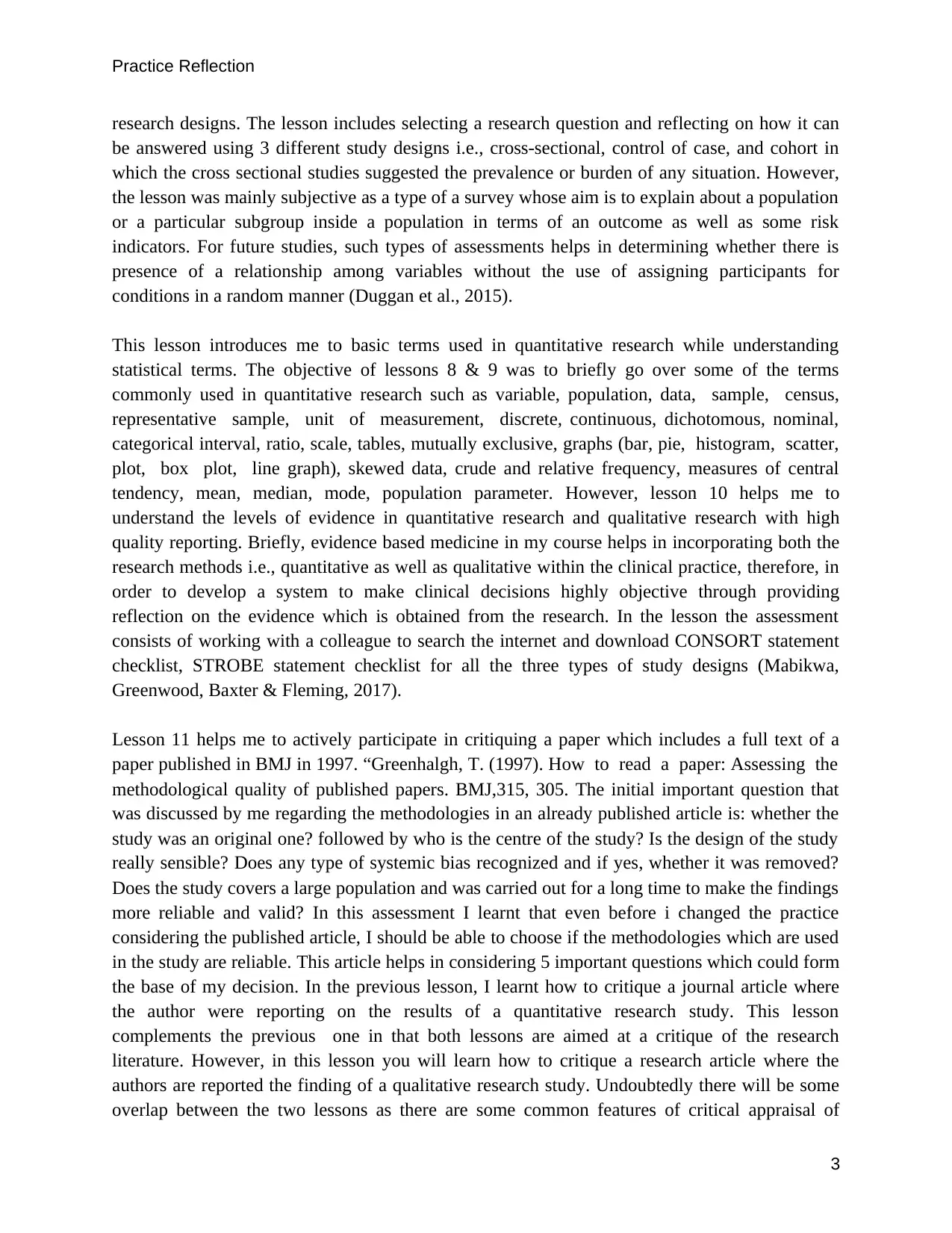
Practice Reflection
research designs. The lesson includes selecting a research question and reflecting on how it can
be answered using 3 different study designs i.e., cross-sectional, control of case, and cohort in
which the cross sectional studies suggested the prevalence or burden of any situation. However,
the lesson was mainly subjective as a type of a survey whose aim is to explain about a population
or a particular subgroup inside a population in terms of an outcome as well as some risk
indicators. For future studies, such types of assessments helps in determining whether there is
presence of a relationship among variables without the use of assigning participants for
conditions in a random manner (Duggan et al., 2015).
This lesson introduces me to basic terms used in quantitative research while understanding
statistical terms. The objective of lessons 8 & 9 was to briefly go over some of the terms
commonly used in quantitative research such as variable, population, data, sample, census,
representative sample, unit of measurement, discrete, continuous, dichotomous, nominal,
categorical interval, ratio, scale, tables, mutually exclusive, graphs (bar, pie, histogram, scatter,
plot, box plot, line graph), skewed data, crude and relative frequency, measures of central
tendency, mean, median, mode, population parameter. However, lesson 10 helps me to
understand the levels of evidence in quantitative research and qualitative research with high
quality reporting. Briefly, evidence based medicine in my course helps in incorporating both the
research methods i.e., quantitative as well as qualitative within the clinical practice, therefore, in
order to develop a system to make clinical decisions highly objective through providing
reflection on the evidence which is obtained from the research. In the lesson the assessment
consists of working with a colleague to search the internet and download CONSORT statement
checklist, STROBE statement checklist for all the three types of study designs (Mabikwa,
Greenwood, Baxter & Fleming, 2017).
Lesson 11 helps me to actively participate in critiquing a paper which includes a full text of a
paper published in BMJ in 1997. “Greenhalgh, T. (1997). How to read a paper: Assessing the
methodological quality of published papers. BMJ,315, 305. The initial important question that
was discussed by me regarding the methodologies in an already published article is: whether the
study was an original one? followed by who is the centre of the study? Is the design of the study
really sensible? Does any type of systemic bias recognized and if yes, whether it was removed?
Does the study covers a large population and was carried out for a long time to make the findings
more reliable and valid? In this assessment I learnt that even before i changed the practice
considering the published article, I should be able to choose if the methodologies which are used
in the study are reliable. This article helps in considering 5 important questions which could form
the base of my decision. In the previous lesson, I learnt how to critique a journal article where
the author were reporting on the results of a quantitative research study. This lesson
complements the previous one in that both lessons are aimed at a critique of the research
literature. However, in this lesson you will learn how to critique a research article where the
authors are reported the finding of a qualitative research study. Undoubtedly there will be some
overlap between the two lessons as there are some common features of critical appraisal of
3
research designs. The lesson includes selecting a research question and reflecting on how it can
be answered using 3 different study designs i.e., cross-sectional, control of case, and cohort in
which the cross sectional studies suggested the prevalence or burden of any situation. However,
the lesson was mainly subjective as a type of a survey whose aim is to explain about a population
or a particular subgroup inside a population in terms of an outcome as well as some risk
indicators. For future studies, such types of assessments helps in determining whether there is
presence of a relationship among variables without the use of assigning participants for
conditions in a random manner (Duggan et al., 2015).
This lesson introduces me to basic terms used in quantitative research while understanding
statistical terms. The objective of lessons 8 & 9 was to briefly go over some of the terms
commonly used in quantitative research such as variable, population, data, sample, census,
representative sample, unit of measurement, discrete, continuous, dichotomous, nominal,
categorical interval, ratio, scale, tables, mutually exclusive, graphs (bar, pie, histogram, scatter,
plot, box plot, line graph), skewed data, crude and relative frequency, measures of central
tendency, mean, median, mode, population parameter. However, lesson 10 helps me to
understand the levels of evidence in quantitative research and qualitative research with high
quality reporting. Briefly, evidence based medicine in my course helps in incorporating both the
research methods i.e., quantitative as well as qualitative within the clinical practice, therefore, in
order to develop a system to make clinical decisions highly objective through providing
reflection on the evidence which is obtained from the research. In the lesson the assessment
consists of working with a colleague to search the internet and download CONSORT statement
checklist, STROBE statement checklist for all the three types of study designs (Mabikwa,
Greenwood, Baxter & Fleming, 2017).
Lesson 11 helps me to actively participate in critiquing a paper which includes a full text of a
paper published in BMJ in 1997. “Greenhalgh, T. (1997). How to read a paper: Assessing the
methodological quality of published papers. BMJ,315, 305. The initial important question that
was discussed by me regarding the methodologies in an already published article is: whether the
study was an original one? followed by who is the centre of the study? Is the design of the study
really sensible? Does any type of systemic bias recognized and if yes, whether it was removed?
Does the study covers a large population and was carried out for a long time to make the findings
more reliable and valid? In this assessment I learnt that even before i changed the practice
considering the published article, I should be able to choose if the methodologies which are used
in the study are reliable. This article helps in considering 5 important questions which could form
the base of my decision. In the previous lesson, I learnt how to critique a journal article where
the author were reporting on the results of a quantitative research study. This lesson
complements the previous one in that both lessons are aimed at a critique of the research
literature. However, in this lesson you will learn how to critique a research article where the
authors are reported the finding of a qualitative research study. Undoubtedly there will be some
overlap between the two lessons as there are some common features of critical appraisal of
3
⊘ This is a preview!⊘
Do you want full access?
Subscribe today to unlock all pages.

Trusted by 1+ million students worldwide
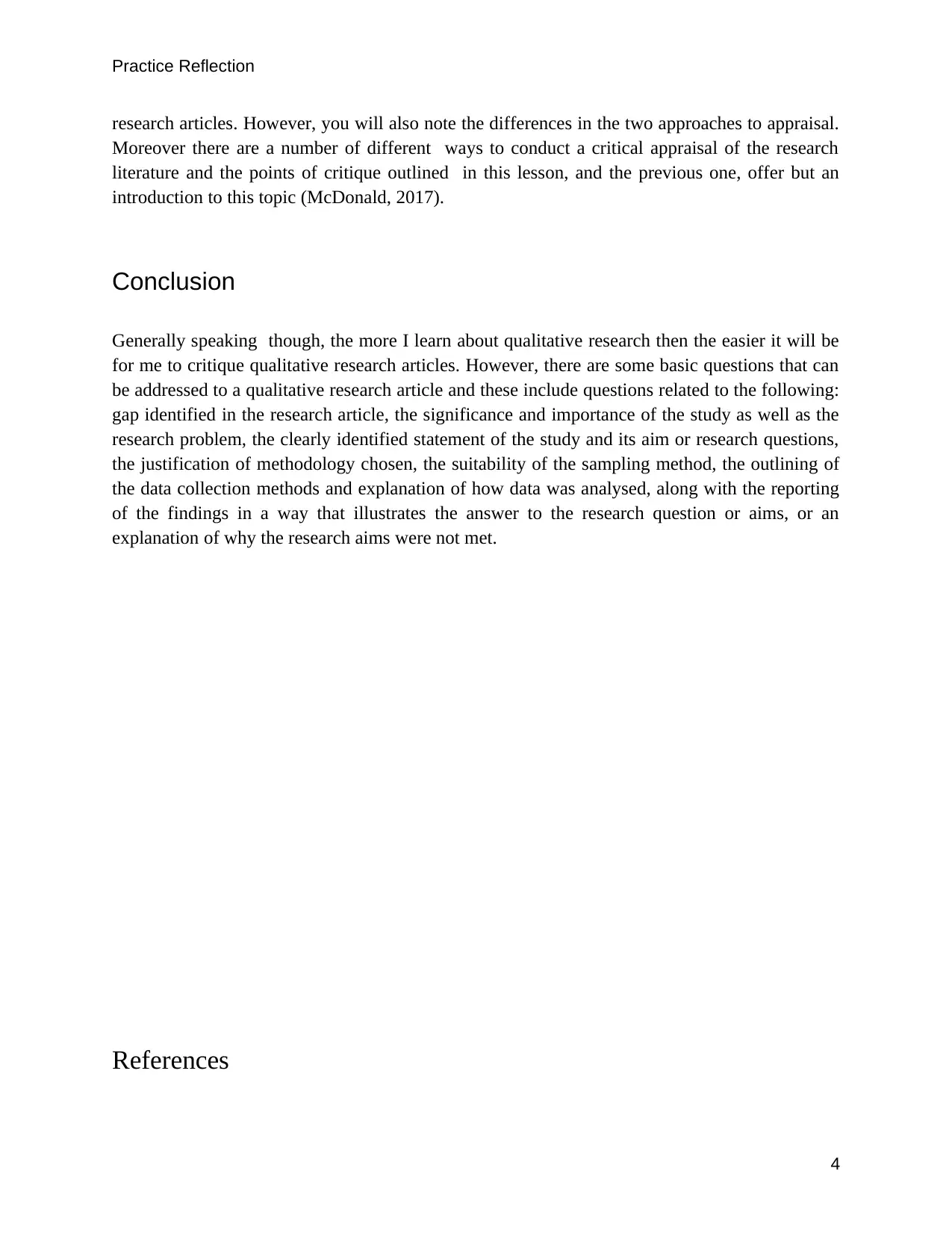
Practice Reflection
research articles. However, you will also note the differences in the two approaches to appraisal.
Moreover there are a number of different ways to conduct a critical appraisal of the research
literature and the points of critique outlined in this lesson, and the previous one, offer but an
introduction to this topic (McDonald, 2017).
Conclusion
Generally speaking though, the more I learn about qualitative research then the easier it will be
for me to critique qualitative research articles. However, there are some basic questions that can
be addressed to a qualitative research article and these include questions related to the following:
gap identified in the research article, the significance and importance of the study as well as the
research problem, the clearly identified statement of the study and its aim or research questions,
the justification of methodology chosen, the suitability of the sampling method, the outlining of
the data collection methods and explanation of how data was analysed, along with the reporting
of the findings in a way that illustrates the answer to the research question or aims, or an
explanation of why the research aims were not met.
References
4
research articles. However, you will also note the differences in the two approaches to appraisal.
Moreover there are a number of different ways to conduct a critical appraisal of the research
literature and the points of critique outlined in this lesson, and the previous one, offer but an
introduction to this topic (McDonald, 2017).
Conclusion
Generally speaking though, the more I learn about qualitative research then the easier it will be
for me to critique qualitative research articles. However, there are some basic questions that can
be addressed to a qualitative research article and these include questions related to the following:
gap identified in the research article, the significance and importance of the study as well as the
research problem, the clearly identified statement of the study and its aim or research questions,
the justification of methodology chosen, the suitability of the sampling method, the outlining of
the data collection methods and explanation of how data was analysed, along with the reporting
of the findings in a way that illustrates the answer to the research question or aims, or an
explanation of why the research aims were not met.
References
4
Paraphrase This Document
Need a fresh take? Get an instant paraphrase of this document with our AI Paraphraser
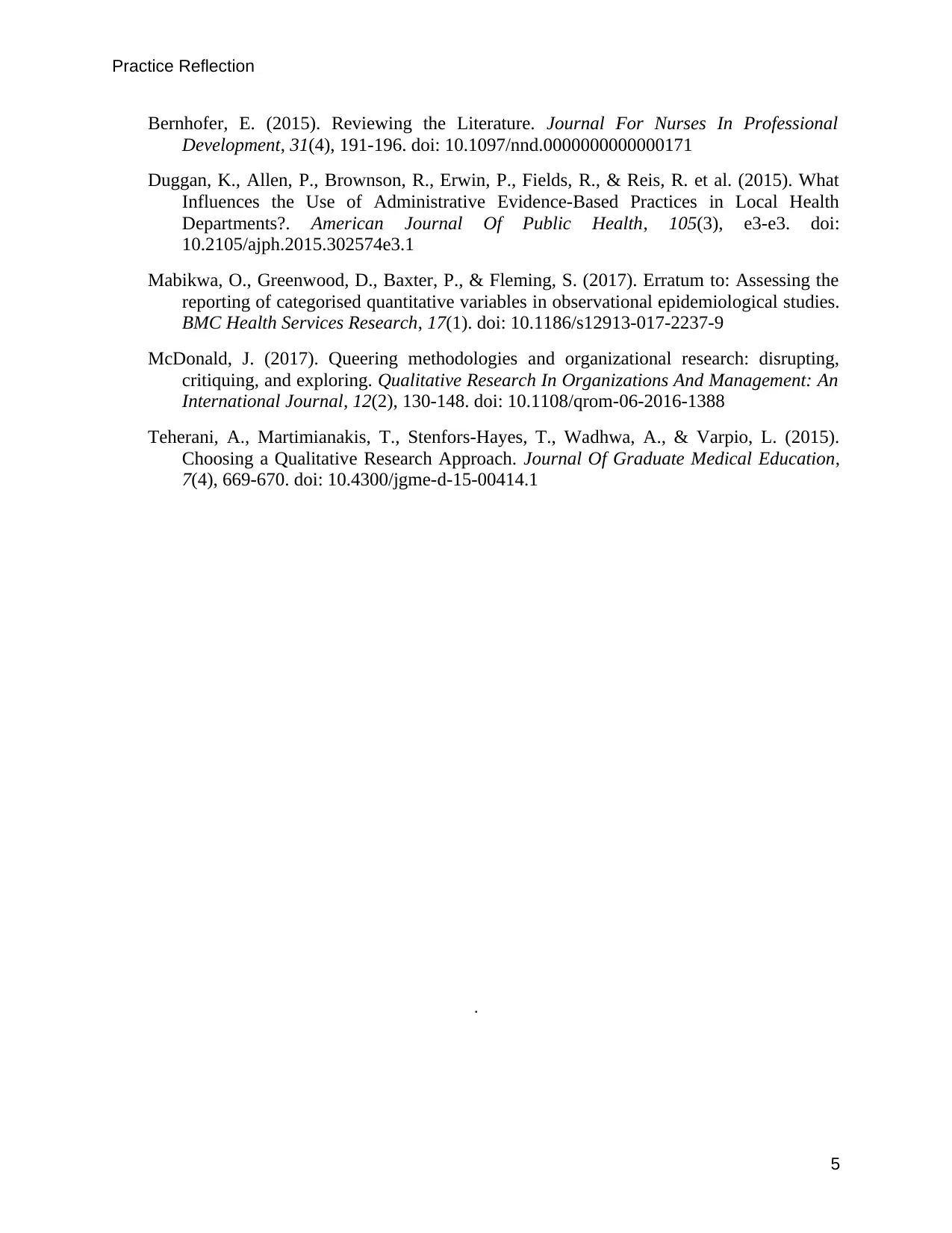
Practice Reflection
Bernhofer, E. (2015). Reviewing the Literature. Journal For Nurses In Professional
Development, 31(4), 191-196. doi: 10.1097/nnd.0000000000000171
Duggan, K., Allen, P., Brownson, R., Erwin, P., Fields, R., & Reis, R. et al. (2015). What
Influences the Use of Administrative Evidence-Based Practices in Local Health
Departments?. American Journal Of Public Health, 105(3), e3-e3. doi:
10.2105/ajph.2015.302574e3.1
Mabikwa, O., Greenwood, D., Baxter, P., & Fleming, S. (2017). Erratum to: Assessing the
reporting of categorised quantitative variables in observational epidemiological studies.
BMC Health Services Research, 17(1). doi: 10.1186/s12913-017-2237-9
McDonald, J. (2017). Queering methodologies and organizational research: disrupting,
critiquing, and exploring. Qualitative Research In Organizations And Management: An
International Journal, 12(2), 130-148. doi: 10.1108/qrom-06-2016-1388
Teherani, A., Martimianakis, T., Stenfors-Hayes, T., Wadhwa, A., & Varpio, L. (2015).
Choosing a Qualitative Research Approach. Journal Of Graduate Medical Education,
7(4), 669-670. doi: 10.4300/jgme-d-15-00414.1
.
5
Bernhofer, E. (2015). Reviewing the Literature. Journal For Nurses In Professional
Development, 31(4), 191-196. doi: 10.1097/nnd.0000000000000171
Duggan, K., Allen, P., Brownson, R., Erwin, P., Fields, R., & Reis, R. et al. (2015). What
Influences the Use of Administrative Evidence-Based Practices in Local Health
Departments?. American Journal Of Public Health, 105(3), e3-e3. doi:
10.2105/ajph.2015.302574e3.1
Mabikwa, O., Greenwood, D., Baxter, P., & Fleming, S. (2017). Erratum to: Assessing the
reporting of categorised quantitative variables in observational epidemiological studies.
BMC Health Services Research, 17(1). doi: 10.1186/s12913-017-2237-9
McDonald, J. (2017). Queering methodologies and organizational research: disrupting,
critiquing, and exploring. Qualitative Research In Organizations And Management: An
International Journal, 12(2), 130-148. doi: 10.1108/qrom-06-2016-1388
Teherani, A., Martimianakis, T., Stenfors-Hayes, T., Wadhwa, A., & Varpio, L. (2015).
Choosing a Qualitative Research Approach. Journal Of Graduate Medical Education,
7(4), 669-670. doi: 10.4300/jgme-d-15-00414.1
.
5
1 out of 5
Related Documents
Your All-in-One AI-Powered Toolkit for Academic Success.
+13062052269
info@desklib.com
Available 24*7 on WhatsApp / Email
![[object Object]](/_next/static/media/star-bottom.7253800d.svg)
Unlock your academic potential
Copyright © 2020–2025 A2Z Services. All Rights Reserved. Developed and managed by ZUCOL.




